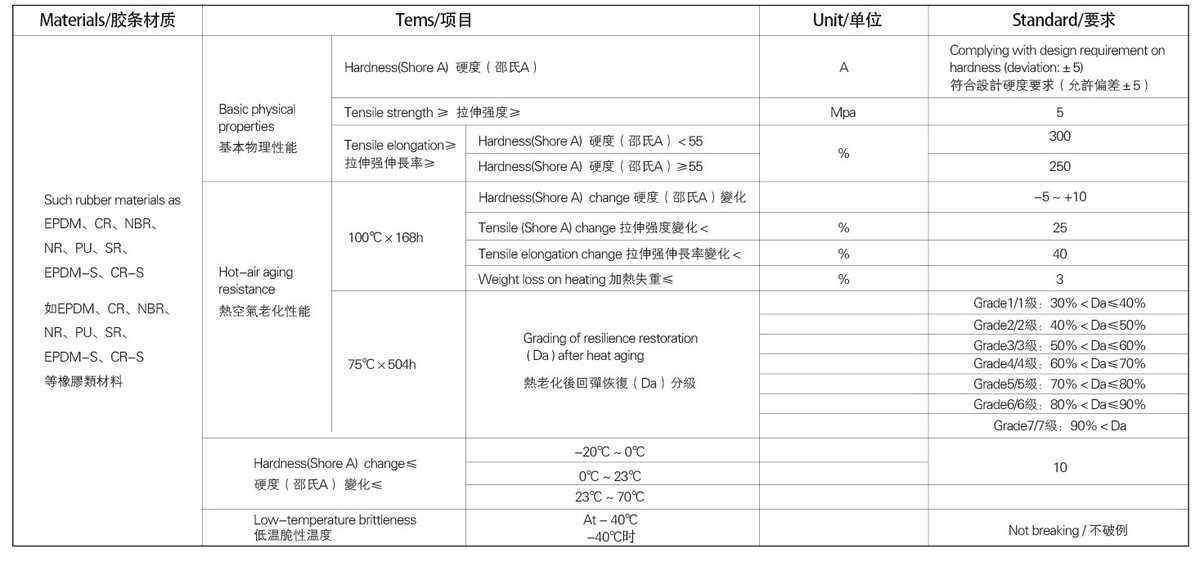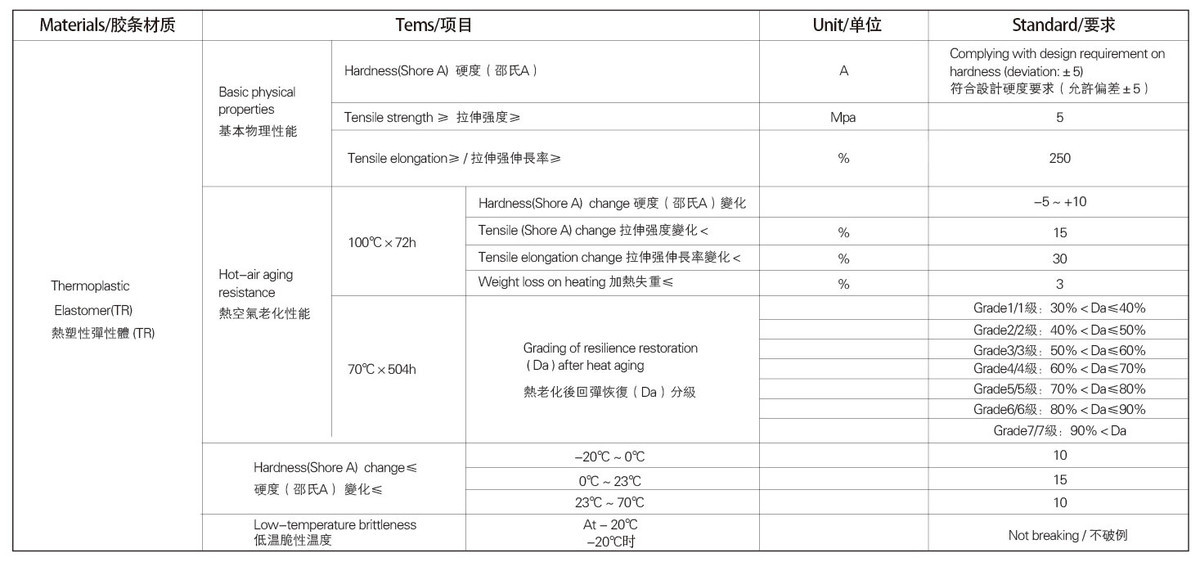English
TECHNICAL INFORMATION
With the development of modem architecture, the style of traditional doors and windows made of wood and steel has been changed to those made of aluminum alloy and plastics that are more decorative and Material saving. At present, steel, aluminum alloy and plastics are equally used to make doors and windows, Doors and windows in construction engineering requires not only the decorative effects in whole, but also such excellent performances as heat insulation, sound insulation, dustproof and air-tightness. The flexible rubber sealing strips,as accessory, enable doors and windows to realize aforesaid excellent performances.
History shows that,' due to the improper selection of rubber seal strips for architectural doors and windows, the following quality defects can always be seen:
The hardness of rubber sealing strips becomes hard and brittle even used for a short period, losing flexibility and sealing function.
Short term after installed, these sealing strips will constringency and fallen off, requiring reworking on the project.
After receiving sunlight or heated, sealing strips become sticky to the window frame or glasses. Sometimes it even leak of grease, which pollutes the doors and windows and affects their sealing function and appearance.
The improper construction, leads illusive installation and the sealing functions losing.
Therefore, selecting good sealing materials and reasonable structure designs becomes the key to solve the above problems.
Overview of architectural rubber sealing strips
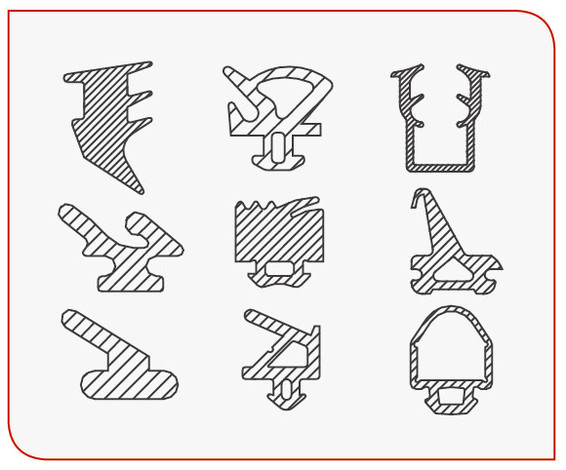
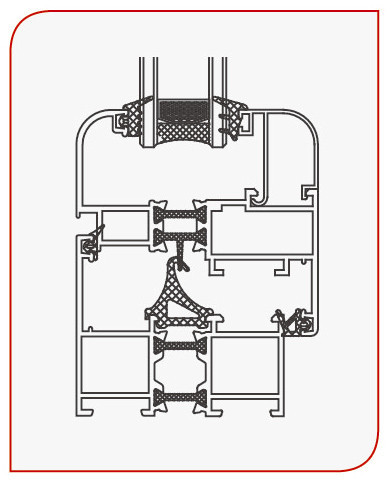
Definition of architectural rubber sealing strips
Technically, the architectural rubber sealing strips refer to strip or bar-shaped materials used on joints of components of architectural doors and windows, such as those of glass and pressing strips, glass and leaves, frames and leaves and those between leaves, which can prevent leakage and invasion of internal and external medium (such as rain, water, air, dust, etc.) ,or prevent mechanical vibration, impact and damage and thus play a role of banding or rod shape material to be air-tightness, sound and heat insulation and insulation effect. (See Figure 1 and 2).
Classification of architectural rubber sealing strips
Sealing strips can be classified as follows according to different references: Based on materials, they can be classified as rubber sealing strip, rubber and plastic sealing strip and plastic seal strip; On structure, solid sealing strip, sponge sealing strip, hollow sealing strip, compound sealing strip (sponge and solid rubber, pure sponge rubber and metal embedded pieces, embedded rubber with metal pieces and sponge leather, solid fabric and so on, anti-static flossed sealing strips and surface-coating sealing strips; on production technique, vulcanized and non-vulcanized sealing strips; on functionality, heat resistance sealing strip, cold resistance sealing strip, grease resistance sealing strip, anti-wear sealing strip and anti-vibration sealing strip; on application, glass sealing strip, frame (leaf) sealing strip, screen sealing strip; on transparency, transparent or non-transparent sealing strips; on decorative effect, sealing strips with different colors.
Working principle
Architectural rubber sealing strips take the advantages of the elasticity on such parts as the cavnm and flange on its body structure(See Figure 1 )to form a contact pressure on the surface of decorative objects (such as glass, metal or non-metal objects), which then can play a role of sealing function. It works usually in temperature ranges from -50 --70℃
Variety of architectural rubber sealing strips
At present, materials used for architectural rubber sealing strips are divided into three types: rubber, plastic and rubber blending with plastic. In foreign countries, rubber is mainly used for that purpose, including CR, NBR, SiR and EPDM. In China, It is mainly used modified plastics, such as including PVC and PP. Besides, the mixed rubber and plastics are also used both at home and abroad. To allow the readers to understand them better, performances and properties of different types of materials for making rubber sealing strips are described as follows:
Rubber
Naturalrubber
It has good antiwear performance, high elasticity and mechanics performance its disadvantages are that it is apt to be swollen and dissolved in mineral oil. and has high alkali resistance but low acid resistance. Working temperature between -55℃- +80 ℃
NBR
NBR :Features include oil resistance, solvent resistance, but it has poor re-sistances to ketone, ester, chlorinated hydrocarbon and other medium. The maintains its shape for long time without deformation, and has good elasticity and mechanics performances. Its disadvantages are that it is apt to be aging and chapped and has poor performance of cold resistance,working temperature between -30 ℃~120℃
CR
"CR" is the short form of "CHLOROPRENE RUBBER"
The CI atoms contained in CR and PVC which allow them to have out-standing performance of flame retardance. CR can slowly burn in fire but the flame will soon be extinguished once CR is isolated from the fire. Under high temperature, the chlorine hydride gas which is decomposed will extinguish the flame.
CR has high mechanical performance, the tensile strength can reach 20- 40Mpa and the break elongation up to 300-600%.
CR has high anti-wear performance. Only about 0.15cm3 of the CR will be worn out if it runs for 1 mile on Akron Abrasion Tester.
CR also has high performance for resistance pressure and deformation. As rubber has good elasticity, the great clamping force can be maintained even if it is pressed and deformed for quite a long time.
SR
Silicone rubber is shortened as SR. SR is a polymer with organosili –con monomer. SR can work in the wide range of temperature, which is between -100 ℃~+300 ℃.
SR is highly ozone-resistant and can be tested in air with ozone content of 150pphm for several months with slightly chapping.
It also has high electric performance, and its volume resistance is (2-10)x1014 Ω. cm. Even if SR is wetted, watered or its temperature risen. its insulation performance can be kept at the same level. Or even SR is burned, the ash is silicon dioxide which is still a insulator. Such a characteristic can avoid the deterioration of the accident when the system is short-circuited.
SR also has high performance for pressing deformation. As rubber has good elasticity, great clamping force can be maintained even if it is pressed and deformed for quite a long time.
SR can be stored in a twenty-year long term.
Polyurethane rubber /
Polyurethane rubber : It has good performances of elasticity, wearability, air-tightness and vibration absorption, and also has medium degree function of oil resistance, oxygen resistance, ozone resistance and aging resistance. Its disadvantage is that is has poor performances for resisting acid, alkali and water. Working temperature between -30°C ~ +80 C.
Employing multi EPDM-S
EPDM-S: Made of a blend of EPDM and SR, providing good performances of the both materials, such as weather resistance, chemical resistance and extreme-temperature resistance. Unlike normal EPDM, it can solve the problem of compatibility between EPDM and SR. Working temperature between -95℃ +200℃
CR -S
CR-S: Made of a blend of CR and SR blend, not only having good performances of CR, such as ozone resistance, weather resistance and flame retardance but also those of the SR, such as high extreme- temperature resistance, ozone resistance, aging resistance, water repellency, air permeability, and incomparable insulation. Unlike normal CR, CR -S can solve the problem of compatibility between CR and SR. Working temperature between -50℃ 〜+150℃
Plastics
Plasticized PVC resin
Polyvinyl chloride is shortened as PVC. PVC is the homopolymer of vi-nyl chloride.
The outstanding characteristic of PVC is its flame retardance. PVC can be burned slowly in fire, but extinguished once the PVC is isolated from the flame.
PVC has high mechanical performance, tensile strength can reach 1.5 - 15Mpa and break elongation 100 - 500%
Under normal temperature, PVC has the same wearability as rubber. However, when temperature is rising, its wearability will become poorer.
PVC's volume resistance can reach 1011 - 1015Ω.com.
PVC also has good water resistance, its water absorption rate is only 0.15% ~0.75% after it is marinated in water for 24 hours.
Plasticized polypropylene resin
it has the same properties as Plasticized PVC resin, and normally used to make transparent products.
Rubber and plastic blends
At present, the following types of rubber and plastic blended are mainly used to make rubber sealing strips:
NBR / PVC blends, earliest use of rubber /plastic blending technology;
Ethylene / EVA / PVC blends;
EPDM / PVC blends;
Polyurethane rubber /PVC blends;
EPDM/PP blends, employing dynamic vulcanization process;
BR / NBR /PVC blends.
EPDM Top-quality EPDM seal strips
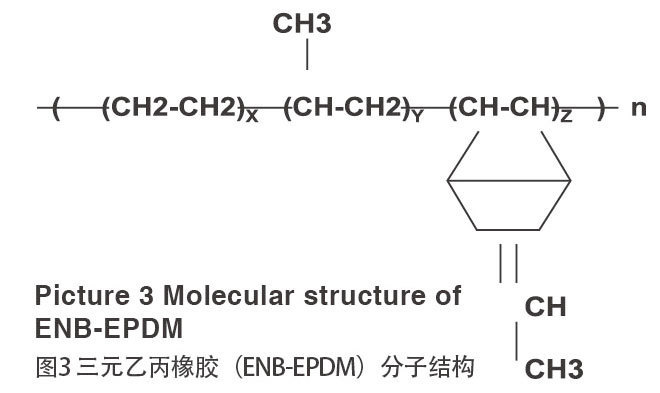
High performance of ozone and oxidation resistances
High performance of ozone and oxidation resistances. As the main chain of EPDM's molecule structure does not contain double bonds (Figure 3), it can resist the attack of ozone in air. No chapping occurs when it works in an environment with ozone concentration of 100pphm for 2430 hours (NBR rubber chapped after 500 hours and CR 40 hours); under the condition of 50PPHM and static tensile 30%, no chapping occurs after 150 hours (NBR rubber chapped after 2 hours). EPDM is often used with diene elastomer to improve ozone and oxidation resistances (When NR and SBR are contacted with ozone, they will become chapped, the flakes will fall off and all physical properties will be degrade).
Thermoplastic elastomer (TPE)
Thermoplastic elastomer (TPE) uses plastic resin as its base and was mixed with rubber by chemical and physical means, which can provide the flexibility and elasticity of the rubber as well as the high-temperature plasticization of plastic. TPE is of various properties and functions. As no vulzanization process is employed and the thermoplastic molding method is used for making the product, the molding cycle is greatly shortened. Besides, the wastes of TPE can be reclaimed and re-used, thus it can save the resources and energy. Such a promising material can be replacement of vulcanized rubber. TPE divide into the following categories: TPS, TPO,TPU, TPEE, etc. The TPE recently developed and used for modified PVC belongs to alkene TPE, mainly including Elvalog741,742 made by Dupont of USA, Chemi- gum P83 by Goodyear, and the Levapren by Bayer of Germany. The modified PVC sealing strips have good performance of resisting pressing deformation.
TPE has the following favorable characteristics: wearability, close to the surface of vehicle tires; waterproof performance, 2% of expansion rate when dipped in the water with a temperature of 100℃for 166 hours; and it is in good performance of weather resistance, after a two thousand-hour test by xenon lamp, the aging resistance coefficient is 102%, elongation aging coefficient 94%,elongation aging coefficient 106%, reaching the same level of EPDM; What's more it is good in flame retardance. TPE can be burned in air but slowly, it complies with requirements of FMVSS302 and considered as slow-flaming material when tested by U.L.94H.B.
Weather resistance
Weather resistance. EPDM can be used for long time under the sunny, humid and cold environment. Vulcanized EPDM with CB can work under direct sunlight for three years, only slightly with chapping or mechanical property changes.
Heat resistance
EPDM can work under the temperature of 120℃ maximally 150℃When temperature is over 150℃ EPDM begins to be decomposed. When added with appropriate anti-aging agent, peroxide or quinone curing system, the interval borne temperature can reach 315℃This characteristic is determined by the saturated main chain structure.
Low-temperature resistance
The flexibility of polymethylene main chain provides good low temperature resistance. The vitrification temperature is between -35℃-65℃ Most of the vulcanized products can kept flexible at -50℃, suggesting its good low- temperature resistance and good performance for pressing deformation. This property can ensure the air-tightness under low-temperature conditions and make the construction work easier in cold environment.
Chemical resistance
EPDM can resist various types of polarity solutes, such as brake fluid, strong acid, strong alkali and alcohol. It has poor performance on resisting non-polarity solutes, like gasoline or other hydrocarbon solutes. After filled by oil with ultra high molecules, EPDM can have medium oil resistance.
High filling power (filling and oil)
EPDM has higher filling volume than any other elastomer (over 200). This nature makes compensation for its disadvantages that it's price higher than regular rubbers (60% higher than SBR, IR, NR). The adoption of oil-filled EPDM with ultra high molecules can enhance the filling power, lower down the processing costs and provide outstanding tensile strength and tensile modulus.
EPDM is almost the lightest rubber when compared to other types (lower than plasticized PVC). Thus its final product is lighter by weight per meter. This nature expands its application greatly.
Apart from the aforesaid advantage (see Figure 1).EPDM also has the feature of small density, good electrical performance, stress adaptability, wearability, moisture resistance and vapor resistance.
When we view the overseas production and application of architectural sealing strips used on window and doors, the following points should be taken into consideration:
Correct selection of sealing strips becomes a critical issue in fabricating architectural doors and windows. Nowadays, engineers no longer follow the way that they measures when sealing strips have failures, but consider sealing strips as an integrated part of the whole process in making the doors and windows.
To completely solve the issue of sealing in architectural doors and windows, excellent materials or reasonable structure may not be the only factor to be considered. "Structure","material", "construction" and "test" are four indispensable parts. If users still hold the old and tradition idea which they can solve the problem of sealing after buying the sealing strips on the market randomly, they will never really solve the issue.
It has become the top priority that research and promote high-quality sealing strips. High quality rubber sealing strips can ensure its matched development with high-quality doors and windows. In recent years, the quality issues arisen from architectural doors and windows are mainly caused by the poor-quality sealing strips.
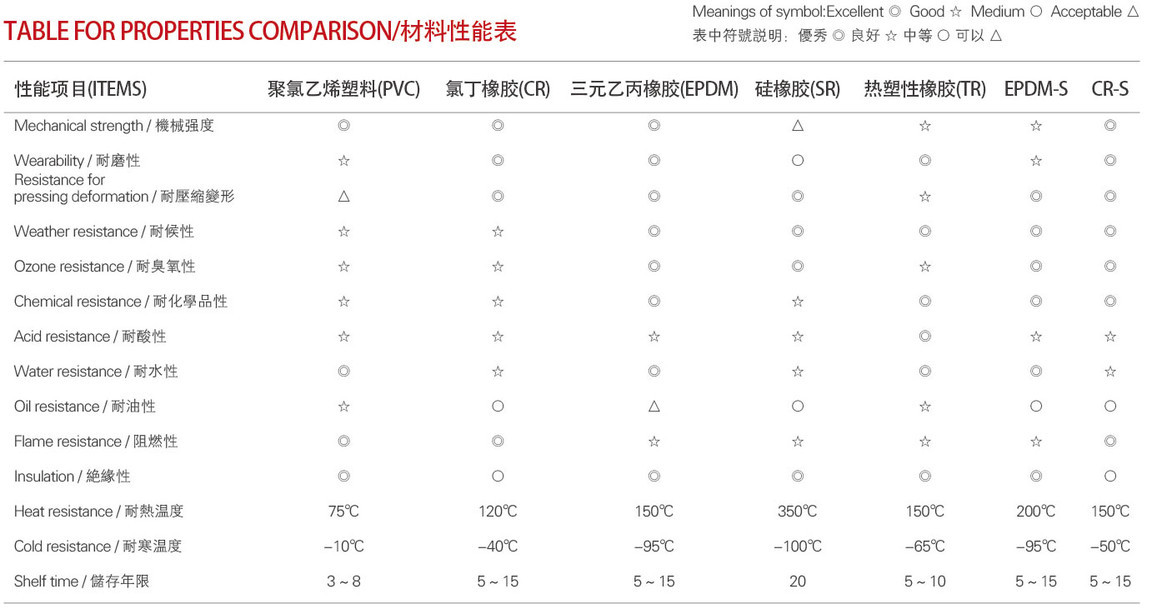
Technical indexes stipulated for rubber seal strips
Standards for Rubber Sealing Strips Used on Architectural Doors and Windows(JG/T187-2006) has been officially issued and publicized and was put into effect from June 1,2007. To allow manufacturers of doors and windows and real estate dealers and developers to understand more about the standard and correctly select the eligible products so as to satisfy the requirements on overall energy saving for buildings, the main performance indexes on materials and products as specified in the Standards are described as follows:
Requirements
5.1 The appearance should be smooth, distortion free, chapping free, bubble free and impurity free, and should have no other defects. The color should be even and consistent.
5.2 Tolerance
The tolerance of rubber sealing strips should be conforming to Table 2 of GB/T3672.1-2000. Among the specifications, Grade EI should be used for installation and Grade E2 for non-installation. Grade N of GB/T3672.2-2000 should be used for the geometrical tolerance of rubber seal strips.
5.3 Properties
5.3.1 Physical properties
The physical properties of sealing strips made of vulcanized rubber should be conforming to requirements in Table 1.those of thermoplastic elastomer conforming to requirements in Table 2.
Note: Commonly used rubber strips made of thermoplastic elastomer: TPV, TPU, Prvc,etc.
5.3.2 Properties of rubber sealing strip products
5.3.2.1 Resilience restoration Under 70℃x 22h, the resilience restoration (Dr) of rubber sealing strips can be graded as follows:
GRADE 1:30% GRADE 2:40% GRADE 3:5lr <=60%
GRADE 4:60% GRADE 5:70% GRADE 6:80% GRADE 7:90%
5.3.2.2 Heat shrinkage rate At 70℃x 24h, the length shrinkage rate should be below 2%
5.3.2.3 After pollution and compatibility tests, polluted mark with light yellow color left by the test sample of rubber sealing strip may be seen on the profiled material and glass. However, it is not allowed to leave solid mark or solid printed trace. Such phenomena as foaming, stickiness and unevenness should not occur on the surface of profiled material, glass and test sample of sealing rubber strip.
5.3.2.4 Aging resistance
5.3.2.4.1 No chapping should occur after 158 hours of ozone and aging resistance test.
5.3.2.4.2 After 4000 hours of light aging test, the test sample should meet the following requirements:
a)Appearance: No chapping occur, the color should not be below Grade 3 when evaluated according to the GB250-1495 grey card gradation.
b)Functionality: When static tensile elongation reaches 50%, the test sample should not be broken
Table 1 Comparisons of physical properties between EPDM and plastics used for doors and windows
